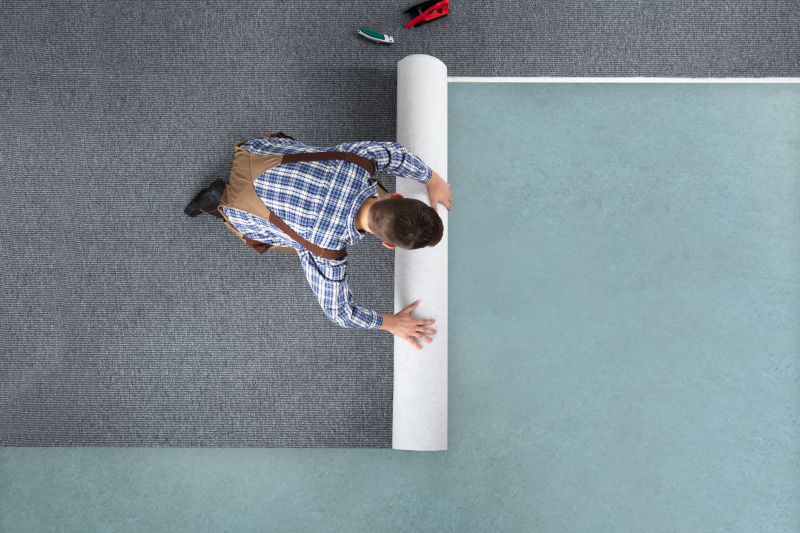Leading Equipment for Efficient Commercial Carpet Installations
Equip yourself with top-performing products designed to enhance productivity and ensure professional-quality results.
 Selecting the right products for commercial carpet installations is essential for ensuring durability, safety, and aesthetic appeal in high-traffic environments. Commercial carpets often face heavy wear and require specialized accessories and installation tools to achieve optimal results. From adhesive solutions to seam rollers, each product plays a vital role in creating a professional and long-lasting finish. Properly chosen materials can facilitate efficient installation processes and contribute to the overall longevity of the carpeted area.
Selecting the right products for commercial carpet installations is essential for ensuring durability, safety, and aesthetic appeal in high-traffic environments. Commercial carpets often face heavy wear and require specialized accessories and installation tools to achieve optimal results. From adhesive solutions to seam rollers, each product plays a vital role in creating a professional and long-lasting finish. Properly chosen materials can facilitate efficient installation processes and contribute to the overall longevity of the carpeted area.
Top Overall Option
Commercial Carpet Adhesive
A high-quality commercial carpet adhesive provides a reliable bond between the carpet and subfloor, ensuring stability and minimizing movement over time. It is formulated to withstand heavy foot traffic and resist wear, making it suitable for various commercial environments. Proper application of this adhesive can facilitate a smooth installation process and contribute to the longevity of the carpet, reducing the need for repairs or replacements.
Types of Products For Commercial Carpet Installations
Carpet Adhesives
Used to secure carpets to the subfloor, available in various formulations for different carpet types and installation conditions.
Seam Sealer
Applied to join seams for a smooth, durable finish that resists unraveling and wear.
Seam Rollers
Tools used to press down seams and ensure tight, even joins between carpet sections.
Power Stretchers
Equipment that helps stretch carpet for a tight fit, especially in large areas or around obstacles.
Carpet Tacks and Staples
Fasteners used to secure carpet edges and borders during installation.
Floor Leveling Compounds
Materials used to prepare uneven subfloors for a smooth carpet installation.
Edge Trimmers
Tools for trimming excess carpet and achieving clean edges.
Underlayments
Padding materials placed beneath the carpet to enhance comfort and durability.
Transition Strips
Metal or vinyl strips used to transition between different flooring types or carpet sections.
Cleaning and Prep Solutions
Products for preparing the subfloor and cleaning the carpet before installation.
Edge Binding Tape
Tape used to secure and finish the edges of carpet installations.
Carpet Lifting Tools
Tools designed to lift and reposition carpets during complex installations or repairs.
Vapor Barriers
Materials installed beneath the carpet to prevent moisture from penetrating the subfloor.
Adhesive Removers
Products for cleaning up excess adhesive and residues after installation.
Carpet Stretcher Bars
Tools that help stretch and secure large sections of carpet for a tight fit.
Popular Choices
Widely used for securing carpets in high-traffic areas due to its strong bonding properties.
Commonly selected for creating seamless, durable joins in commercial settings.
Popular for achieving tight, professional finishes in large installations.
Frequently used for cleanly trimming excess carpet during installation.
Essential for smooth transitions between different flooring types in busy commercial spaces.
Often chosen to protect against moisture issues in certain environments.
Popular for improving comfort and extending carpet lifespan in commercial areas.
Commonly used for efficient cleanup after installation tasks.
Frequently employed to ensure tight seams and uniform appearance.
Popular for preparing uneven subfloors in commercial projects.
Often used for securing edges and borders during installation.
Commonly selected for finishing carpet edges neatly.
The process of installing commercial carpets involves multiple steps, including surface preparation, adhesive application, carpet placement, and finishing touches. High-quality adhesives are crucial for securing the carpet to the subfloor and preventing shifting or bubbling over time. Seam sealing products help create smooth, invisible joints that withstand foot traffic. Additionally, tools such as power stretchers and seam rollers assist installers in achieving tight, even seams and proper tension.
Durability and safety are also key considerations when selecting products for commercial carpet installation. Slip-resistant adhesives and backing materials can help reduce the risk of accidents. Moreover, choosing products compatible with various carpet types ensures versatility across different commercial settings. Effective installation not only enhances the visual appeal but also extends the lifespan of the carpet, making it a worthwhile investment for business owners and facility managers.
Investing in the right products can streamline the installation process, minimize waste, and promote a professional finish. Whether working on large office complexes, retail spaces, or hospitality venues, understanding the available options and their specific uses helps in making informed choices. Proper training and familiarity with these products can further improve installation quality, ensuring the space remains functional and attractive for years to come.
Key Buying Considerations
- Compatibility with carpet type and subfloor material
- Adhesive strength and drying time suitable for high-traffic areas
- Ease of application and cleanup processes
- Flexibility and bond durability over time
- Weather and temperature resistance of adhesives and sealants
- Impact on indoor air quality and VOC emissions
- Availability of matching accessories like seam sealer and transition strips
- Ease of use of installation tools such as stretchers and trimmers
- Cost-effectiveness considering durability and lifespan
- Compatibility with existing flooring transition requirements
- Resistance to moisture and potential for mold or mildew
- Requirement for professional installation versus DIY suitability
- Safety features and handling instructions for adhesives and chemicals
- Size and coverage area of products to minimize waste
- Brand reputation and customer reviews for reliability
